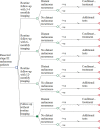Cost-effectiveness analysis of PET/CT surveillance imaging to detect systemic recurrence in resected stage III melanoma: study protocol
- PMID: 33154047
- PMCID: PMC7646332
- DOI: 10.1136/bmjopen-2020-037857
Cost-effectiveness analysis of PET/CT surveillance imaging to detect systemic recurrence in resected stage III melanoma: study protocol
Abstract
Introduction: In the new era of effective systemic therapies for advanced melanoma, early detection of lower volume recurrent disease using surveillance imaging can improve survival. However, intensive imaging follow-up strategies are likely to increase costs to health systems and may pose risks to patients. The objective of this study is to estimate from the Australian health system perspective the cost-effectiveness of four follow-up strategies in resected stage III melanoma over a 5-year period following surgical treatment with curative intent.
Methods and analysis: A decision-analytic model will be built to estimate the costs and benefits of (1) 12 monthly, (2) 6 monthly, (3) 3-4 monthly positron emission tomography/CT imaging for 5 years, compared with (4) no imaging follow-up. The model will be populated with probabilities of disease recurrence, test performance measures using data from >1000 consecutive resected stage III melanoma patients from Melanoma Institute Australia diagnosed between 2000 and 2017. Healthcare resource use, including surveillance imaging, doctor's visits, subsequent tests and procedures to investigate suspicious findings, will be quantified from detailed patient records and valued using Australian reference pricing. Economic outcomes include cost per new distant melanoma recurrence detected and cost per diagnostic error avoided, for no imaging compared with the other strategies.Deterministic sensitivity analyses will examine the robustness of model results.
Ethics and dissemination: This study was approved by the Sydney Local Health District, Sydney Local Health District Ethics Review Committee (RPAH Zone), AU/1/830638 and the Australian Institute of Health and Welfare (EO2019-1-454). The results of this study will be published in peer-reviewed medical and health economics journals and will inform melanoma management guidelines.
Keywords: health economics; oncology; radiology & imaging; risk management.
© Author(s) (or their employer(s)) 2020. Re-use permitted under CC BY-NC. No commercial re-use. See rights and permissions. Published by BMJ.
Conflict of interest statement
Competing interests: RS received honoraria from Novartis and MSD for an advisory capacity.
Figures
Similar articles
-
The Impact of Surveillance Imaging Frequency on the Detection of Distant Disease for Patients with Resected Stage III Melanoma.Ann Surg Oncol. 2022 May;29(5):2871-2881. doi: 10.1245/s10434-021-11231-3. Epub 2022 Feb 10. Ann Surg Oncol. 2022. PMID: 35142966 Free PMC article.
-
Cost-Effectiveness of PET/CT Surveillance Schedules to Detect Distant Recurrence of Resected Stage III Melanoma.Int J Environ Res Public Health. 2022 Feb 17;19(4):2331. doi: 10.3390/ijerph19042331. Int J Environ Res Public Health. 2022. PMID: 35206519 Free PMC article.
-
Performance of Long-Term CT and PET/CT Surveillance for Detection of Distant Recurrence in Patients with Resected Stage IIIA-D Melanoma.Ann Surg Oncol. 2021 Aug;28(8):4561-4569. doi: 10.1245/s10434-020-09270-3. Epub 2021 Jan 3. Ann Surg Oncol. 2021. PMID: 33393039
-
Optimal surveillance strategies for patients with stage 1 cutaneous melanoma post primary tumour excision: three systematic reviews and an economic model.Health Technol Assess. 2021 Nov;25(64):1-178. doi: 10.3310/hta25640. Health Technol Assess. 2021. PMID: 34792018
-
Prostate-specific membrane antigen positron emission tomography in the management of recurrent prostate cancer.Br Med Bull. 2018 Dec 1;128(1):37-48. doi: 10.1093/bmb/ldy032. Br Med Bull. 2018. PMID: 30272121 Review.
Cited by
-
The Impact of Surveillance Imaging Frequency on the Detection of Distant Disease for Patients with Resected Stage III Melanoma.Ann Surg Oncol. 2022 May;29(5):2871-2881. doi: 10.1245/s10434-021-11231-3. Epub 2022 Feb 10. Ann Surg Oncol. 2022. PMID: 35142966 Free PMC article.
-
Cost-Effectiveness of PET/CT Surveillance Schedules to Detect Distant Recurrence of Resected Stage III Melanoma.Int J Environ Res Public Health. 2022 Feb 17;19(4):2331. doi: 10.3390/ijerph19042331. Int J Environ Res Public Health. 2022. PMID: 35206519 Free PMC article.
-
Comparison of CT, MRI, and F-18 FDG PET/CT for initial N-staging of oral squamous cell carcinoma: a cost-effectiveness analysis.Eur J Nucl Med Mol Imaging. 2022 Sep;49(11):3870-3877. doi: 10.1007/s00259-022-05843-4. Epub 2022 May 24. Eur J Nucl Med Mol Imaging. 2022. PMID: 35606526 Free PMC article.
-
18 F-FDG positron emission tomography-computed tomography has a low positive predictive value for detecting occult recurrence in asymptomatic patients with high-risk Stages IIB, IIC, and IIIA melanoma.J Surg Oncol. 2022 Mar;125(3):525-534. doi: 10.1002/jso.26737. Epub 2021 Nov 6. J Surg Oncol. 2022. PMID: 34741547 Free PMC article.
References
-
- Australian Institute for Health and Welfare (AIHW) Australian cancer incidence and mortality (ACIM) books: melanoma of the skin, 2015.
Publication types
MeSH terms
LinkOut - more resources
Full Text Sources
Medical

